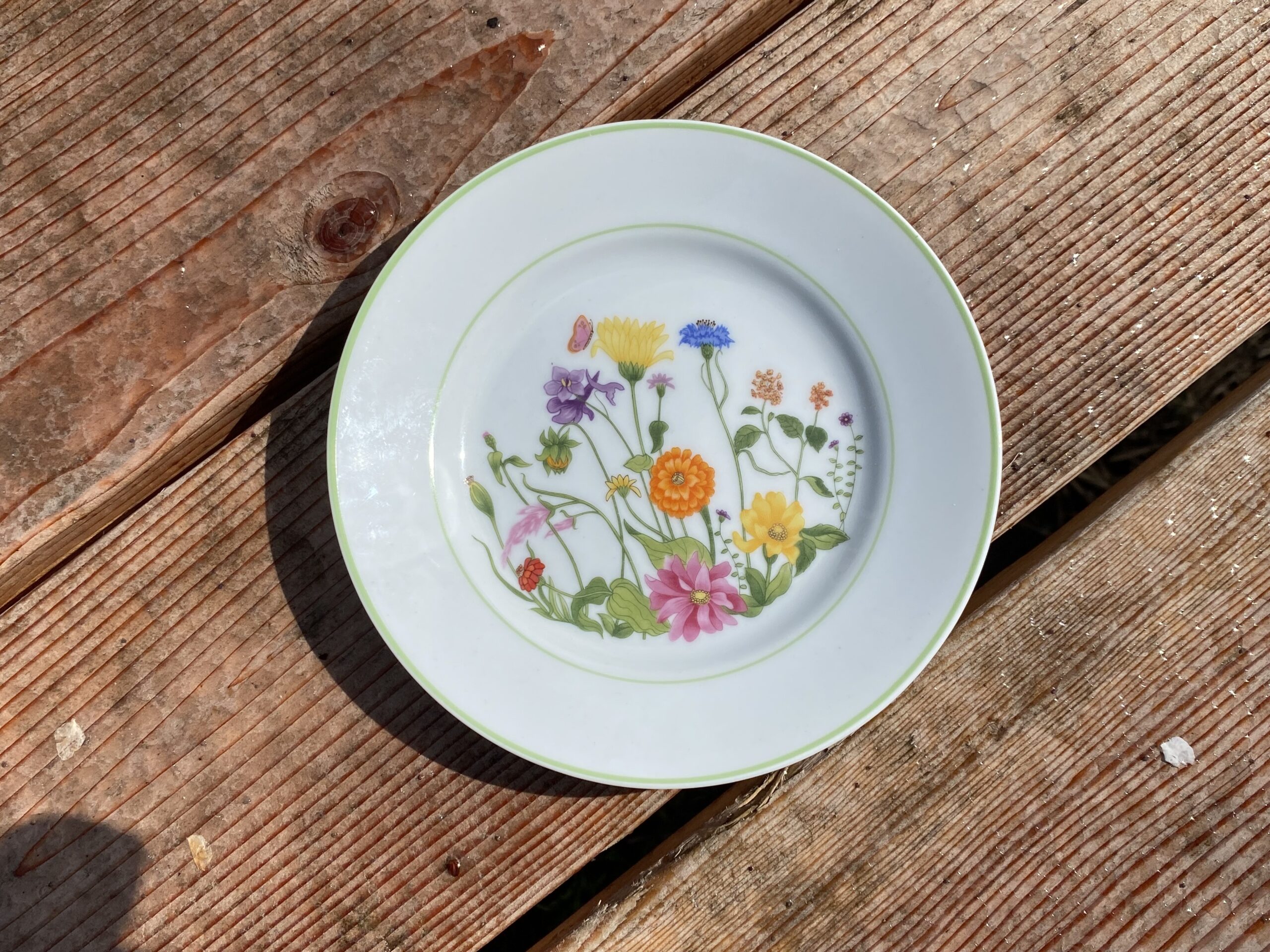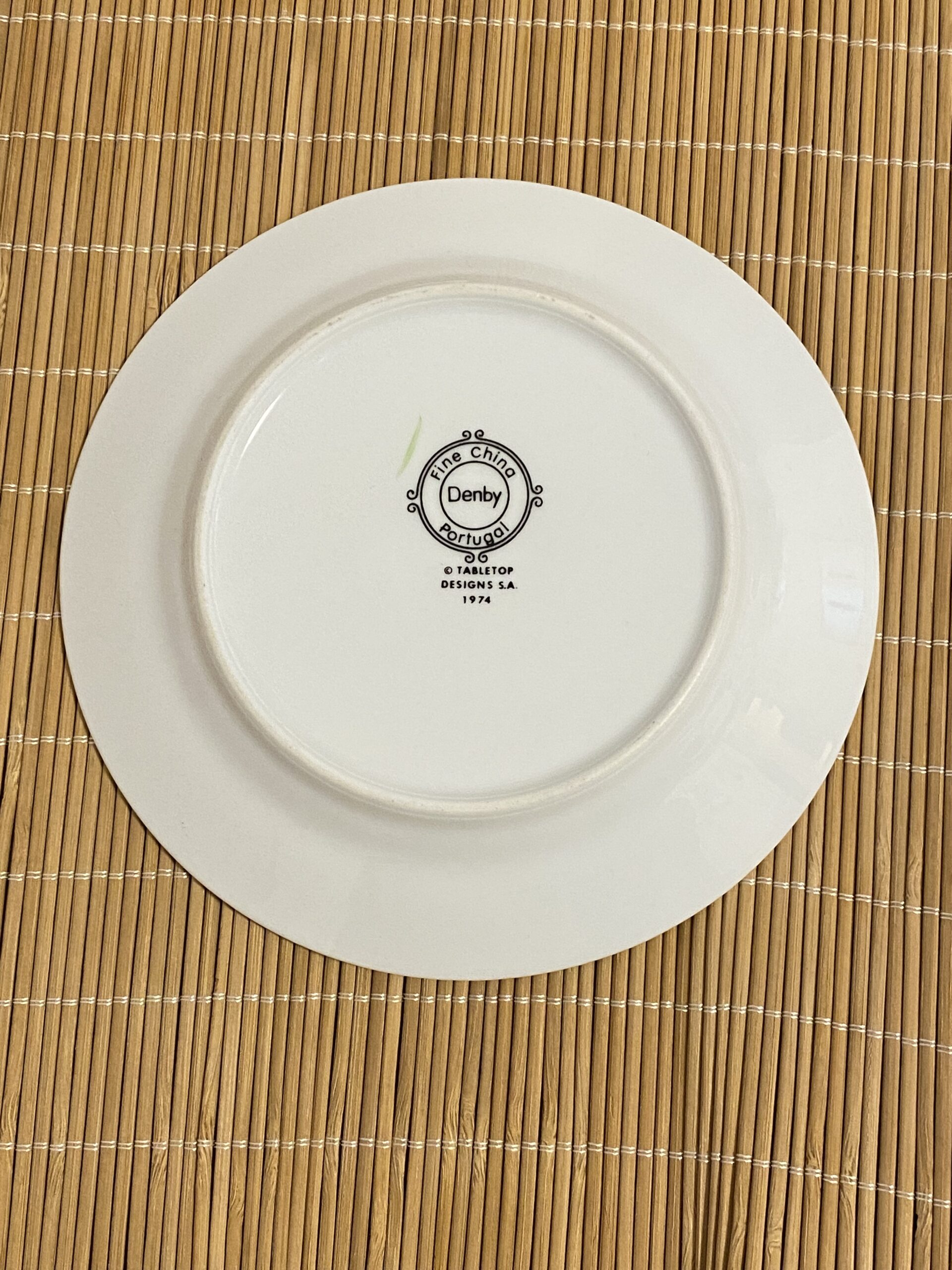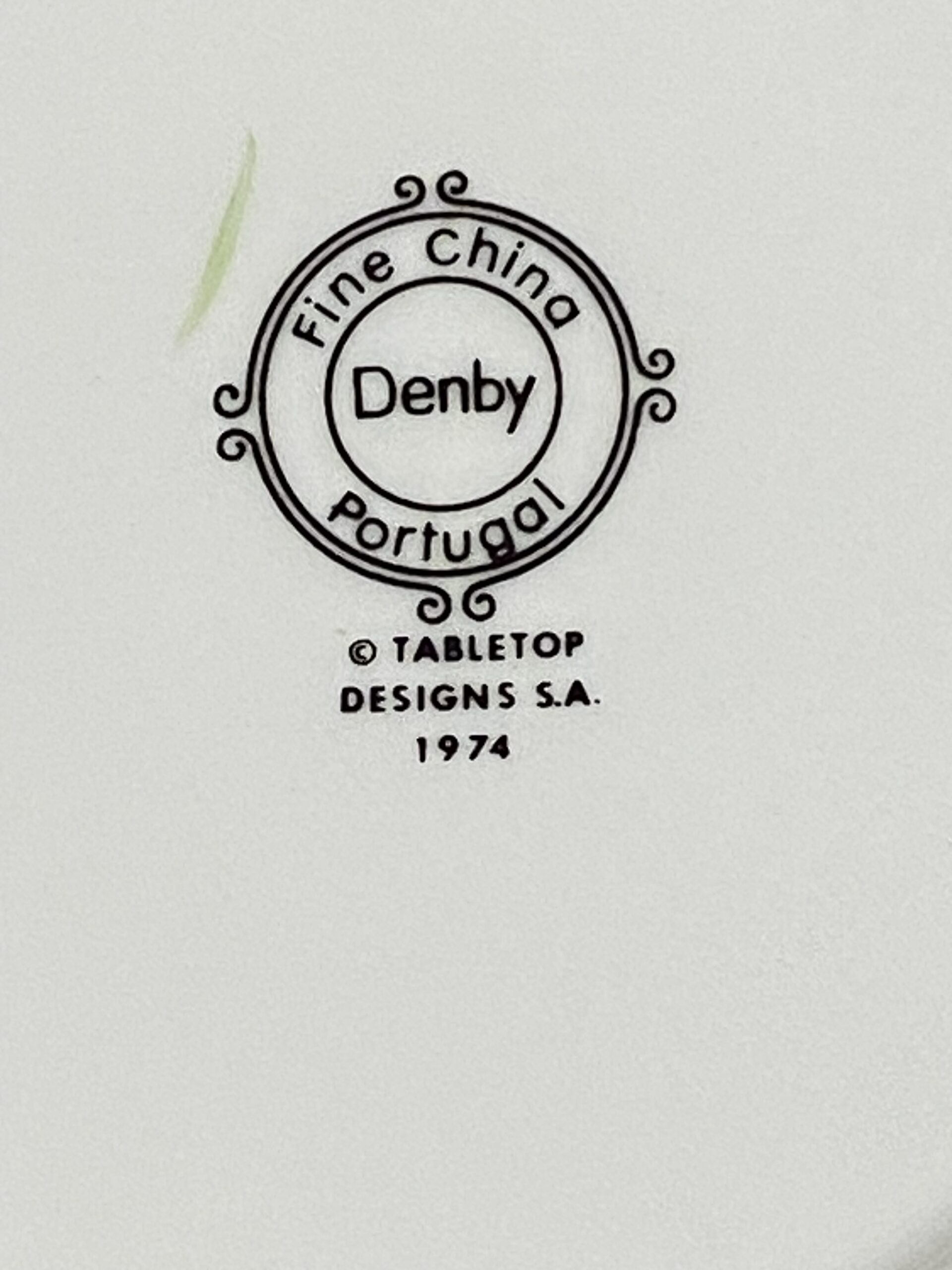Denby Floral Pattern Fine China Tabletop Designs 1974, Made in Portugal: as high as 24,500 ppm Lead on the food surface
Introduction (for those new to this website):
Tamara Rubin is a Federal-award-winning independent advocate for consumer goods safety and a documentary filmmaker. She is also a mother of Lead-poisoned children, her sons were acutely Lead-poisoned in 2005. Since 2009 Tamara has been using XRF testing (a scientific method used by the U.S. Consumer Product Safety Commission) to test consumer goods for toxicants (specifically heavy metals), including Lead, Cadmium, Mercury, Antimony, and Arsenic. All test results reported on this website are science-based, accurate, and replicable. Items are tested multiple times, to confirm the test results for each component tested. Tamara’s work was featured in Consumer Reports Magazine in February of 2023.
April 19, 2023 — Wednesday
XRF Test Results for the Dish Pictured
Context: Total Lead-content (as detectable with an XRF instrument) in the paint, glaze, or coating of an item manufactured for use by adults is not regulated in any way.
- Dishes are considered “items intended for use by adults” (not items intended for use by children — even though kids obviously use dishes) unless they have been expressly manufactured and sold as children’s dishes.
- A few examples of items manufactured expressly for children to use would be dishes sold as “baby dishes” by Bunnykins/Royal Doulton (link), Tiffany & Co (link), or Wedgwood/Beatrix Potter (link).
- Modern children’s items (made today) are not legally allowed to have Lead levels above 90 ppm in the paint, glaze, or coating.
Most Important Consideration: Vintage dishware was often manufactured before modern leach-testing standards were in place, regardless of whether or not there were relevant total-content standards in place at the time of manufacture. Given it is rare for a set of dishes to be marked with the date of manufacture, users of these products often have no idea what the product’s actual age is (which relates to whether or not they were even leach-tested at the time of manufacture).
In addition to this concern, even if vintage dishes were manufactured after modern leach-testing standards were in place, those standards are only relevant in determining whether or not the product is safe and not leaching Lead from the food contact surface glaze at the time of manufacture (i.e. when the dishes were new). This means that if a product is compliant with leach-testing regulatory limits at the time of manufacture, yet contains a high level of Lead in the glaze, it may leach Lead at some point in the future — especially after years (even decades) of daily use in a home, and particularly if used with hot or acidic foods and liquids like tomato/citrus-based sauces, or vinegar-based dressings. It is, for this reason, we recommend never using vintage dishware that tests positive for any amount of Lead on the food-contact surface of the dish — especially for levels of Lead at 90 ppm or higher.
COBALT: These particular Denby dishes also test positive for fairly significant levels of Cobalt (in at least one of the glaze colors on the food surface) — which can be a metal of concern. If you personally have had a metals panel test (blood, urine, or hair testing) and your results showed an unsafe or unusual level of Cobalt, it is probably a good idea to avoid using food with dishes/kitchenware/pots/pans, etc. that have blue or purple glazes/ finishes/ decorative elements (especially for use with hot or acidic foods and beverages).
Some additional reading:
- To read more about the concern for Lead in pottery and china, click here.
- For the menu of this website (where you can look through different categories of items tested by Lead Safe Mama, LLC) — click here.
- To see XRF test results for more “Made in Portugal” pieces we have tested, click here.
- To see more Denby pieces we have tested, click here.
- To learn more about sending in an item from your home for Lead Safe Mama, LLC to test, click here.
Color-Code Key to XRF Readings Below
Metals noted in RED are considered toxic heavy metals in most applications.
Metals noted in ORANGE are considered toxic in some applications (specifically with ingestion).
Metals noted in BLUE are not considered toxic in this application.
Metals noted in GRAY were not found to be present (with the low threshold of detection for the XRF instrument normally falling in the single or double-digit ppm for most metals).
Reading #1) Center of Food Surface on Dish (White Area)
60-second test (repeated multiple times to confirm results)
- Lead (Pb): 21 +/- 8 ppm
- Cadmium (Cd): 8 +/- 4 ppm
- Tin (Sn): 18 +/- 7 ppm
- Mercury (Hg): non-detect
- Selenium (Se): non-detect
- Barium (Ba): non-detect
- Chromium (Cr): non-detect
- Antimony (Sb): non-detect
- Copper (Cu): non-detect
- Zinc (Zn): 25 +/- 11 ppm
- Manganese (Mn): non-detect
- Zirconium (Zr): non-detect
- Indium (In): non-detect
- Iron (Fe): 2,553 +/- 166 ppm
- Bismuth (Bi): 102 +/- 11 ppm
- Vanadium (V): non-detect
- Platinum (Pt): non-detect
- Gold (Au): non-detect
- Cobalt (Co): non-detect
- No other metals were detected in consumer goods mode.
Reading #2) Food Surface of Dish — Orange Flower
60-second test (repeated multiple times to confirm results)
- Lead (Pb): 9,842 +/- 190 ppm
- Cadmium (Cd): 590 +/- 19 ppm
- Tin (Sn): 28 +/- 9 ppm
- Mercury (Hg): non-detect
- Selenium (Se): non-detect
- Barium (Ba): non-detect
- Chromium (Cr): non-detect
- Antimony (Sb): 27 +/- 13 ppm
- Copper (Cu): 48 +/- 22 ppm
- Zinc (Zn): 593 +/- 36 ppm
- Manganese (Mn): non-detect
- Zirconium (Zr): 512 +/- 16 ppm
- Indium (In): 12 +/- 7
- Iron (Fe): 1,523 +/- 139 ppm
- Bismuth (Bi): 84 +/- 24 ppm
- Vanadium (V): non-detect
- Platinum (Pt): 299 +/- 58 ppm
- Gold (Au): non-detect
- Cobalt (Co): non-detect
- No other metals were detected in consumer goods mode.
Reading #3) Food Surface of Dish — Yellow Flower
60-second test (repeated multiple times to confirm results)
- Lead (Pb): 20,600 +/- 400 ppm
- Cadmium (Cd): 28 +/- 6 ppm
- Tin (Sn): 91 +/- 11 ppm
- Mercury (Hg): 69 +/- 24 ppm
- Selenium (Se): non-detect
- Barium (Ba): non-detect
- Chromium (Cr): non-detect
- Antimony (Sb): 527 +/- 24 ppm
- Copper (Cu): 73 +/- 25 ppm
- Zinc (Zn): 582 +/- 38 ppm
- Manganese (Mn): non-detect
- Zirconium (Zr): 498 +/- 18 ppm
- Indium (In): 27 +/- 8 ppm
- Iron (Fe): 3,095 +/- 189 ppm
- Bismuth (Bi): 76 +/- 34 ppm
- Vanadium (V): non-detect
- Platinum (Pt): 499 +/- 79 ppm
- Gold (Au): non-detect
- Cobalt (Co): non-detect
- No other metals were detected in consumer goods mode.
Reading #4) Food Surface of Dish —Blue Flower
60-second test (repeated multiple times to confirm results)
- Lead (Pb): 24,500 +/- 500 ppm
- Cadmium (Cd): 57 +/- 7 ppm
- Tin (Sn): 22 +/- 10 ppm
- Mercury (Hg): non-detect
- Selenium (Se): non-detect
- Barium (Ba): non-detect
- Chromium (Cr): 367 +/- 241 ppm
- Antimony (Sb): non-detect
- Copper (Cu): 38 +/- 23 ppm
- Zinc (Zn): 3,931 +/- 116 ppm
- Manganese (Mn): non-detect
- Zirconium (Zr): 542 +/- 20 ppm
- Indium (In): non-detect
- Iron (Fe): 707 +/- 113 ppm
- Bismuth (Bi): 91 +/- 38 ppm
- Vanadium (V): non-detect
- Platinum (Pt): 512 +/- 87 ppm
- Gold (Au): non-detect
- Cobalt (Co): 4,763 +/- 192
- No other metals were detected in consumer goods mode.
Reading #5) Back Mark of Dish — Logo Area (Black)
60-second test (repeated multiple times to confirm results)
- Lead (Pb): 2,631 +/- 68 ppm
- Cadmium (Cd): 55 +/- 6 ppm
- Tin (Sn): 22 +/- 7 ppm
- Mercury (Hg): non-detect
- Selenium (Se): non-detect
- Barium (Ba): non-detect
- Chromium (Cr): 1,562 +/- 292 ppm
- Antimony (Sb): 17 +/- 11 ppm
- Nickel (Ni): non-detect
- Copper (Cu): 33 +/- 21 ppm
- Zinc (Zn): 493 +/- 32 ppm
- Manganese (Mn): 1,918 +/- 214 ppm
- Titanium (Ti): non-detect
- Zirconium (Zr): non-detect
- Indium (In): non-detect
- Iron (Fe): 3,355 +/- 189 ppm
- Vanadium (V): non-detect
- Platinum (Pt): 123 +/- 38 ppm
- Gold (Au): non-detect
- Cobalt (Co): 1,422 +/- 105 ppm
- Bismuth (Bi): 69 +/- 14 ppm
- No other metals were detected in consumer goods mode.
In Conclusion
I would not consider these dishes safe for use with food, especially given the levels of Lead (and the presence of other toxic heavy metals) found in the center of the food surface of the dish.
- If you have these dishes — or any vintage Denby china — and have been using them as your everyday set, you may want to consider asking your doctor about getting a Blood Lead Level (BLL) test to rule out any potential exposure. Here’s a link with more information about BLL testing.
- This consideration also extends to any other vintage china you use regularly that may have high-Lead glaze (you can look your dishes up at this link or by putting the brand name into the search bar at the top of any page of this website).
- Given BLL testing tends to show immediate/recent exposure (there is a 30 to 45-day “half-life” of Lead in the blood — link with details), if you are more concerned about long-term exposure ask your doctor about the possibility of getting a hair, or urine test. Here’s a link with more information about those types of testing.
- If you are looking for examples of Lead-free (and Cadmium-free) dishes to use as alternatives, please check out this link.
~ End ~
Never Miss an Important Article Again!
Join our Email List











